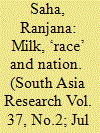|
|
|
Sort Order |
|
|
|
Items / Page
|
|
|
|
|
|
|
| Srl | Item |
| 1 |
ID:
107500


|
|
|
|
|
| Publication |
2011.
|
| Summary/Abstract |
Greenhouse gas (GHG) emissions from reservoirs have been under the microscope for more a decade now. In particular, the high CH4 emissions reported in warm systems have tarnished the green credentials of hydroelectricity in terms of GHG emissions. Reliable estimates of CH4 emissions are crucial, since CH4 has a greenhouse warming potential of 25 and because, unlike CO2, CH4 emissions should be counted for the entire life cycle of a reservoir. Up to now, the highest CH4 emissions from reservoirs have been measured in warm latitudes, thus adding an argument against the use of hydroelectricity in these regions. However, to our knowledge, GHG emissions have been measured for only 18 of the 741 large dams (>10 MW, according to the ICOLD register) listed in the tropics. This article reviews the limited scientific information available and concludes that, at this time, no global position can be taken regarding the importance and extent of GHG emissions in warm latitudes.
|
|
|
|
|
|
|
|
|
|
|
|
|
|
|
|
| 2 |
ID:
153130


|
|
|
|
|
| Summary/Abstract |
This article analyses medical opinion about nursing of infants by memsahibs and dais as well as the Bengali-Hindu bhadramahila as the ‘immature’ child-mother and the ‘mature’, ‘goddess-like’ mother in the tropical environment of nineteenth and early twentieth century Bengal. It shows how the nature of lactation, breast milk and breastfeeding are socially constructed and become central to medical advice on motherhood and childcare aimed at regenerating community, ‘racial’ and/or national health, including manly vigour for imperial, colonial and nationalist purposes. In colonial Bengal, the topic of breastfeeding surfaces as crucial to understanding colonial and nationalist, medical and medico-legal representations of maternal and child health constituted by gendered, racialised, classed and caste-ridden, biological/cultural and pure/polluting traits, often considered transferable through milk and blood.
|
|
|
|
|
|
|
|
|
|
|
|
|
|
|
|
|
|
|
|
|